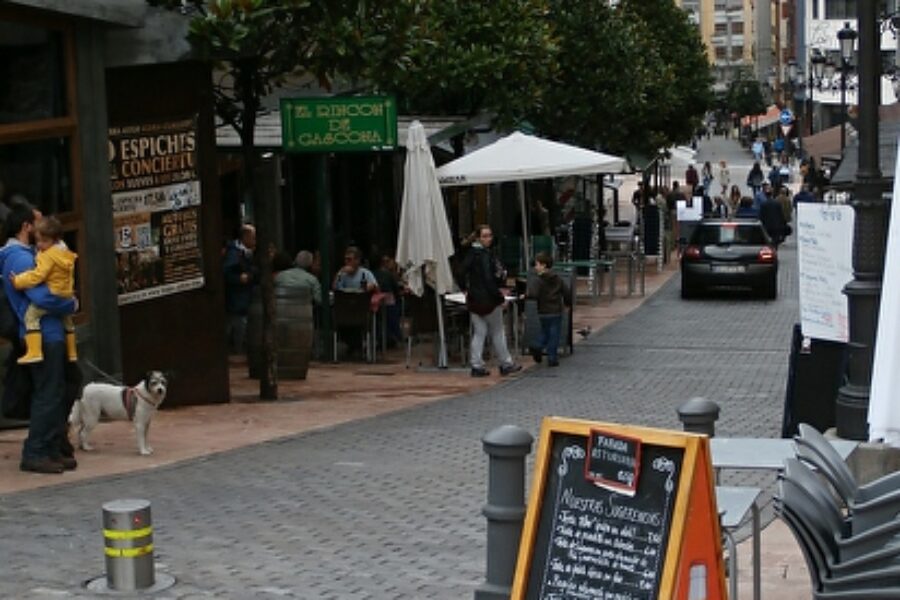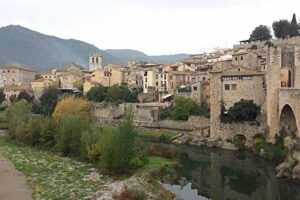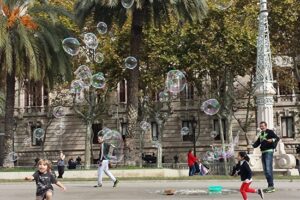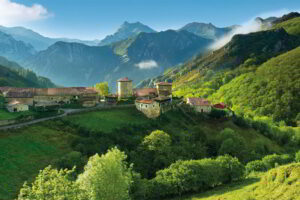Learning to Wash Clothes all Over Again
I sit on the floor in our rented apartment in Oviedo, phone in hand, looking at the display on my washing machine. The only thing I understand is Rapido. Everything else I must look-up on my iTranslate app. The phone and I work things out. I add Ariel Gel to the dispenser, press the appropriate buttons—and –success! I can only hope — remembering the bleached out clothes that emerged from the washing machine in San Miguel. Different type of washer. Different detergent. I check the back of the bottle and the only thing I understand is P&G.
The washing done, I climb the ladder to hang the clothes from the suspended clothesline near the ceiling. I have more clothes and more lines than clothespins.
Lunch at Tierra Astur
It is 1:45 p.m. My stomach growls.

We stumbled onto the boulevard of cider—Calle Gascona—earlier this week, and cider being a mainstay of Asturias it is finally time to do the tourist thing. The steep street, from top to bottom, is nothing but sidrarias—where lunch too is on the menu.

Too many cider houses to choose from we don’t know where to start. We see many people head for the first sidraria on the street—Tierra Astur. The name rings a bell. I can’t remember why. We follow the crowds.

The interior is very rustic, and I point out the chairs do not look that comfortable. We like to linger. These do not look like lingering chairs. A decision is made for us. We are seated at a table for two, the chairs being as I expected, but the place is cute. I move my foot back and forth on the tiles. Sawdust! On the floor! In Spain!
The menu goes on for days—it is like ordering at Chili’s. This is the very first restaurant since arriving in Spain where the menu has items listed in English as well as Spanish—with pictures—like Chili’s. I smell a tourist trap.
We each order an appetizer. “Too much,” our waiter tells us. “Only one for two persons.”
We settle on fried Asturian cheese—Cabrales— served with membrillo. Michael orders a sausage plate. I order hake baked in a cheese sauce on a bed of potatoes and pimento. Too much! The plates are piled high, my piece of hake is humongous. I almost feel this place is owned or operated by an Americano.
Drinking Sidra in Oviedo

But…we are here for the sidra. Knowing nothing, we let our waiter guide us. The hard cider tastes unfamiliar. Not sweet. Different. Nothing to fall in love with immediately; nothing to reject either. Much milder than beer—not bitter—light and refreshing with approximately the same alcohol content. But still foreign. I’m not quite sure how I feel about it.
To make the sidra sing (fizz) the waiter, one hand held high above his head, spills the sidra in a single stream onto the inside lip of a thin wide-rimmed glass held below his waist in the other hand. Michael points out the experts keep their eyes straight ahead—watching only the cascade of cider at eye level. They are so fast I am having a very hard time catching one in the act of the pour.
The waiters facing us look to be in a trance, their backs to the patrons whose glasses they fill. The glass is handed to the waiting customer with a flourish, holding barely enough for a tasting—maybe an inch. The ritual is repeated over and over again till the bottle of sidra is empty. It is totally against the rules to pour your own—even if you are thirsty and the waiter is busy.

A Church to Explore – San Julián de los Prados
We make ourselves walk down the hill we know we will have to walk back up. This is the price we pay to see the oldest of three pre-Romanesque churches that have given Oviedo a World Heritage Site status and the only one within the city limits.

Michael dodges traffic, skirts fences, walks on sidewalks, crosses highways, and leads us straight to San Julián de los Prados, only to find a sign saying the church will not open till 4 p.m. The sign, in Spanish, takes a minute to interpret. We find a bench at the back of the ancient edifice and sit down in the not-quite-drizzle—waiting and reading a bare-bones sketch about the property. My guidebook tells me King Alfonso II built the church in 812, taking 30 years to complete and mentioning something about Asturian kingdom and Visigoth order. I need to know more. I am overly perturbed about not having continuous access to a WIFI.

There is an admission price, and signs tell me — as loudly as a silent sign can — NO PICTURES! I think that I will have to lift some interior photos from Google images to remember this. The church is adorned in geometrics. Plain. Simple. No gold embellishments. A guide walks over to where I sit, pointing at the ceiling, explaining in Spanish what I am looking at.
I remain clueless as to the significance of what I see.


We tackle the hill. Then we shop. Every evening we stop at El Corte Ingles, where we shop for dinner, buying wine, cheese, olives, a baguette, and pastries for breakfast. It is a ritual and only two short blocks from the apartment. I remember other towns where we have done the same. A walking town. A flat walking town — it is what I covet.










Leave a Reply
Your email is safe with us.